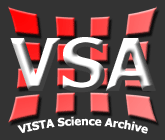VSA will soon move to
vsa.roe.ac.uk
VSA Home |
|
|
|
|
|
|
|
|
|
|
|
|
|
|
|
|
|
|
|
|
|
|
|
|
|
|
|
|
|
|
|
|
|
|
|
|
|
|
|
|
|
|
|
|
|
|
|
|
VSA Questions and Answers
Before contacting vsa-support@roe.ac.uk if
you have a query about accessing the VSA please see
if it has already been covered in the Q&A listed below. (note: please do not
contact individuals in the Wide-Field Astronomy Unit, use vsa-support@roe.ac.uk).
General look-ups between tables *Source and *Detection.
In general when querying the *Source table, you may find that certain catalogue quantities
that you need are not present. This is because the table design in the VSA is to
write only a subset of the most useful attributes available from *Detection into *Source (for
efficiency reasons). For example, CASU standard source extraction produces 13 aperture
magnitudes for every detection in every passband and these are of course present in
*Detection, but in *Source you will only see a subset of 3 per passband - aperMags 3, 4
and 6 for example. How do you query if you are interested in an aperture magnitude
other than 3, 4 or 6 - say aperMag2 in the J band for a VMC query?
The answer is to do a join query between *Source and *Detection,
noting that each row of *Source is a member of a frame set the details of
which are stored in *MergeLog (hence the join has to include *MergeLog as well).
The SQL syntax is best illustrated by an example:
SELECT s.ra, s.dec, jd.aperMag2 as jAperMag2
FROM vmcSource AS s, vmcMergeLog AS l, vmcDetection as jd
WHERE
/* Join source to merge log for the frame set: */
s.frameSetID=l.frameSetID AND
/* Join merge log to detection for the J frame: */
l.jmfID = jd.multiframeID AND l.jeNum = jd.extNum AND
/* Join source to detection to look up the detection required: */
s.jSeqNum = jd.seqNum
Note that the final predicate could be done via objID:
... AND s.jobjID = dj.objID but this is most inadvisable for
efficiency reasons (the attribute combination multiframe number,
extension number, sequence number is the primary key in
*Detection so look-ups are very fast on that combination) and
furthermore for the more subtle reasons detailed
Coordinates - decimal degrees, sexagesimal, radians:
Coordinates in the VSA are primarily stored as decimal degrees. The region
search page does accept sexagesimal format but the results are returned
as decimal degrees.
Note: RA and Dec values are returned as decimal degrees except when written
to FITS files where radians are used .
Home |
Overview |
Browser |
Access |
Login |
Cookbook
Listing |
FreeSQL
Links |
Credits
WFAU, Institute for Astronomy,
Royal Observatory, Blackford Hill
Edinburgh, EH9 3HJ, UK
vsa-support@roe.ac.uk
24/1/2014
|

